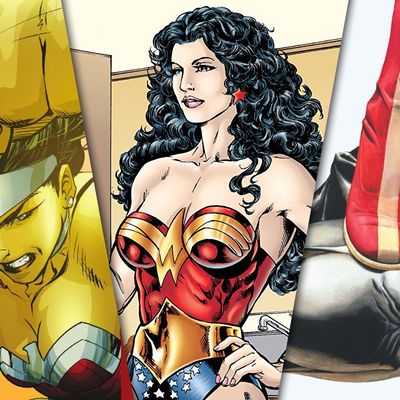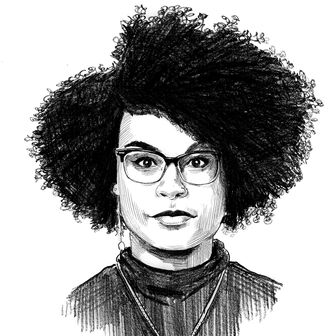
Princess. Ambassador. Warrior. Paragon of peace and truth. There are many sides to Wonder Woman, also known as Diana of Themyscira, yet director Patty Jenkins’s upcoming adaptation marks the first appearance of Wonder Woman in live action on the big screen. That Wonder Woman hasn’t been afforded the same opportunities as Batman and Superman despite being one the longest running and undoubtedly most iconic female characters in comic-book history is appalling. If you ask comic fans why it took 75 years for Wonder Woman to make her film debut, you’ll likely hear the same old excuses: Her origin is too tricky, her background is too weird, or most infuriatingly, that she doesn’t have iconic stories.
It’s time to set the record straight: Wonder Woman is a bold character with enough outstanding comics in her arsenal that it’s hard to recommend just seven. I was initially tempted to add Brian Azzarello and Cliff Chiang’s first collection from their three-year run on the character, since it seems to be a touchstone for the Gal Gadot film, but I thought it would be best to recommend works that exemplify Wonder Woman at her best — a skilled warrior who is nearly unparalleled in a fight, but prefers to extend a helping hand before the end of her sword. If you’re looking to understand the character before the film’s June 2 premiere, these comics are the perfect place to start.
Wonder Woman by George Perez Omnibus by George Perez, Len Wein, Greg Potter, Bruce Patterson, John Costanza, and Tatjana Wood
Yes, I am recommending George Perez’s entire run on Wonder Woman. Why? Perez’s work as a writer and artist is the gold standard for Wonder Woman in the modern age. The men and women involved in bringing this bold new take on Wonder Woman to fruition used the opportunity of Crisis on Infinite Earths (which rebooted the DC Universe) to shape the character in fascinating ways while remaining true to her core ethos. There are a few factors essential to the character ever since William Moulton Marston created her in 1941 as a beacon of feminist values: She was born on an all-woman island of warriors known as Themyscira (earlier referred to as Paradise Island); she was raised by the Queen of the Amazons, Hippolyta; and after Steve Trevor crashes on the island, a contest to determines who will visit the outside world precipitates Diana’s transformation into the hero we know her to be. Perez and his collaborators build upon these essential aspects in moving ways: The Greek mythology is heightened, the Amazons are given new backstory that puts the feminist politics center stage, and Wonder Woman becomes immensely more powerful than she had been before (gaining the ability to fly, among others powers she’s granted by patron goddesses like Artemis and Aphrodite). Perez is also responsible for injecting much needed diversity within the mythos, thanks to characters like Philippus, who plays an integral role in raising Diana. Perez’s Wonder Woman offers something no other major comic-book character does with such a depth of emotion and beauty: It’s a coming-of-age story rooted in an essentially female power fantasy.
The Hiketeia by Greg Rucka, J.G. Jones, Wade von Grawbadger, Dave Stewart
Whenever I hear someone deride Wonder Woman for not having any iconic stories, I point them in the direction of this 2002 comic, which can be found in the first volume of Greg Rucka’s amazing run on the character. My love for this blistering and powerful story begins with its amazing cover by artist J.G. Jones, which presents an immediately tantalizing image of Wonder Woman’s signature red-and-white boots grinding on Batman’s wincing face. What more could you ask for? The Hiketeia distills the political and loyal nature of Wonder Woman as she’s tasked with protecting a young woman who went on a revenge murder spree in Gotham, but Batman isn’t the only antagonist Wonder Woman finds herself facing. Both the Furies and her own status as an ambassador puts immense pressure on her. Come to see Wonder Woman put Batman in his place, stay for the complex rendition of her commitment to the Amazonian ethos and the nature of justice among superheroes.
JLA: A League of One by Christopher Moeller
In Justice League comics, Wonder Woman often gets relegated to minor roles to provide space for the richer narratives granted to Superman and Batman, or she’s forced to act as a bloodthirsty warrior woman even though it directly contradicts what her character represents. But Christopher Moeller — who wrote and painted this story — had different plans for the Amazonian princess. Moeller’s gorgeous writing and art leans into the mythic nature of Wonder Woman. JLA: A League of One is a fable that sees Wonder Woman make difficult choices in to save her Justice League comrades from a prophecy that proclaims their death. She also battles a dragon, which is pretty cool.
Sensation Comics Featuring Wonder Woman Vol. 2 by Various Writers and Artists
One of the most intriguing aspects of Wonder Woman is her mutability. Sensation Comics takes advantage of this by giving a host of writers and artists a chance to put their own spin on the heroine. This collection of short comics vault between young-adult simplicity, heavy science fiction, space opera, and moving stories about mother-daughter relationships. The art is at times buoyant, other times surreal. If you’ve never read Wonder Woman before, I’d recommend this collection, since there is something for everyone. Wonder World, written by James Tynion IV and drawn by Noelle Stevenson, is a sweet coming-of-age story in which a young Diana escapes Themyscira to explore Man’s World, finding fun, companionship, and ice cream with girls her age. Venus Rising, written by Alex De Campi with art by Neil Googe, is a pure space-opera epic, offering sharp commentary on Wonder Woman’s place in the Justice League and how she deals with the scrutiny of social media. It’s work like this collection that shows the humanity in Wonder Woman’s character. She isn’t unerringly perfect, but a woman with foibles and struggles that can actually be relatable.
Wonder Woman #170: A Day in the Life by Phil Jimenez, Joe Kelly, Andy Lanning
This issue, which is a part of the Paradise Lost collection set to be rereleased on June 6 and currently available on its own digitally, is undoubtedly one of the most emotionally and morally complex stories from Wonder Woman’s 75-year history. Its premise is deceptively simple: Wonder Woman is mired in the fallout from a Themysciran civil war that left her stripped of her title as princess and unable to return to the place she calls home. Enter Lois Lane, who spends an entire day with Wonder Woman as she jets from dive bars to refugee camps to the White House to visit President Lex Luthor. In just a few pages, Jimenez evocatively depicts the breadth of Wonder Woman’s character — the pressure she’s under, the many lives she’s lived, and the politics she adheres to. A Day in the Life also sees Wonder Woman reckon with the privilege that comes with being a goddess-blessed, royal superhero who fits a revered beauty ideal.
The Circle by Gail Simone, Terry Dodson, Bernard Chang, Rachel Dodson, Alex Sinclair, et. al.
You’ve probably noticed there are far too few women creators on this list, given that Wonder Woman is a character intrinsically tied to feminism. Consider it a byproduct of a terribly male-dominated industry. Of course, Simone’s work on Wonder Woman — which is at its best in this first volume — gets a mention not because of her gender. The Circle is a poignant rendition of Wonder Woman’s origins and the compassion at the heart of her character. Simone adds a wrinkle to Wonder Woman’s origins that addresses the reactions to her birth by other Amazons who are unable to have children. After forming Wonder Woman out of clay granted life by Aphrodite, a sharp division within Queen Hippolyta’s personal guard threatens to rip Themyscira apart. Wonder Woman eventually inspires hope, but the seed of fear planted within these fearsome warriors ends up having devastating consequences on the character’s past, present, and future. The collection is worth the cover price alone for how artists Terry and Rachel Dodson conceive of Wonder Woman. She’s never been more beautiful and imposing.
Wonder Woman Vol 1: The Lies and Wonder Woman Vol 2: Year One by writer Greg Rucka and artists Liam Sharp and Nicola Scott
Okay, this is a cheat, but it’s hard for me to separate these two collections. The Lies and Year One have been running at the same time, each presenting complex, evocative portraits of Wonder Woman at different points in her life. One of the best things DC Comics has done recently is its Rebirth revamp, which once again rebooted the characters only a few years after a similar but less successful effort with the New 52. Perhaps the smartest Rebirth decision was bringing back Greg Rucka to pen Wonder Woman, considering he had done what I consider the best run on the character in the early 2000s. The Lies reckons with the many changes to Wonder Woman’s origin in a meta way that may be a bit overwhelming for newcomers, but it is a brutal and intense story — aided by Liam Sharp’s great art — that fleshes out her major relationships with Steve Trevor, Etta Candy, and her friend turned foe Barbara Ann Minerva, a.k.a. Cheetah. By comparison, Year One is more approachable. The title says it all: It’s about Diana’s journey from the naïve Amazon princess to the superhero who brings a message of peace to Man’s World. The art by Nicola Scott is vibrant in ways the character hasn’t been depicted in years. What draws me to both stories, along with Greg Rucka’s work with the character in general, is that it exemplifies what makes Wonder Woman such a fascinating superhero: She’s a trenchant refutation of the typical, toxic masculine power fantasies of her peers.





